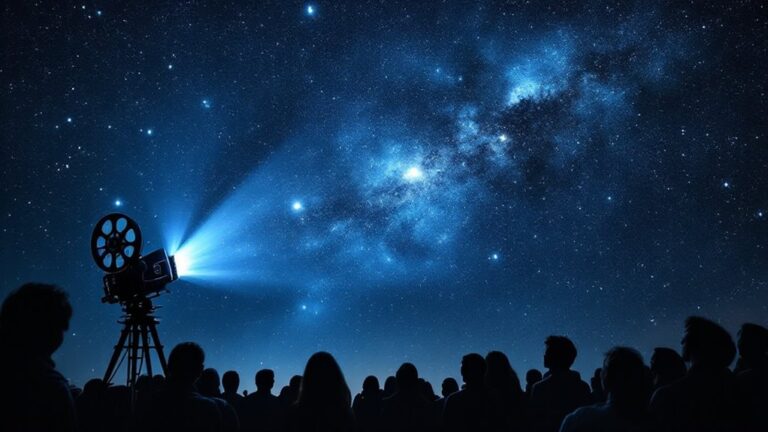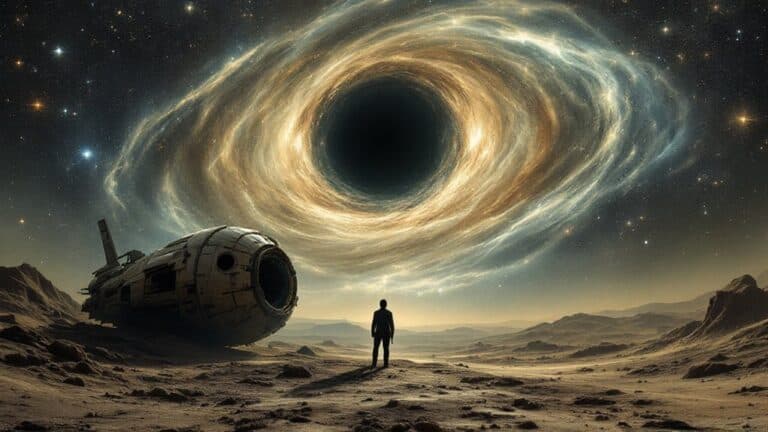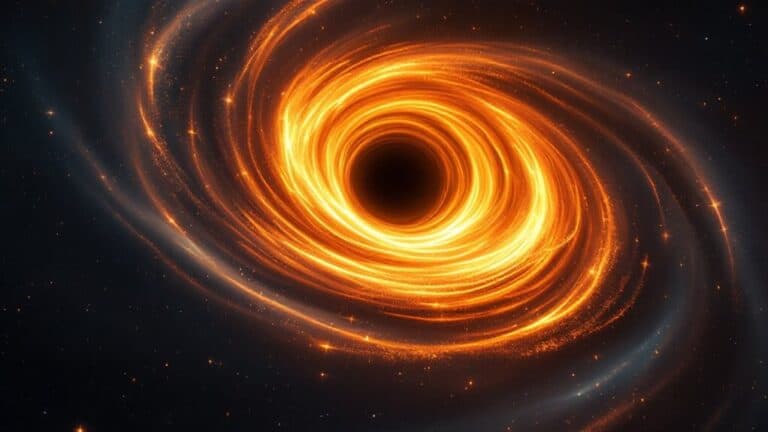The Organ in Interstellar: A Symbol of Hope and Despair
The organ in *Interstellar* symbolizes both hope and despair, bridging science and spirituality in profound ways. Its majestic tones evoke deep emotional resonance, grounding the narrative’s exploration of human connections amid cosmic vastness. As it mirrors the characters’ emotional struggles, the organ illustrates the duality of existence, where love transcends isolation and time. This interplay of musicality enriches the film’s themes of sacrifice and resilience, illuminating how individuals confront despair through their relationships. Ultimately, the organ invites you to reflect on the complexities of life and the enduring power of love as a guiding force through uncertainty.
Table of Contents
Key Takeaways
- The organ’s majestic sound enhances emotional depth, evoking both hope and despair within the vastness of space and human experience.
- Its melodies contrast isolation, highlighting characters’ longing for connection and the sacrifices made for the greater good.
- The organ symbolizes the duality of human existence, merging scientific exploration with spiritual themes of love and transcendence.
- Music from the organ mirrors emotional struggles, capturing the essence of sacrifice and resilience amid despair throughout the film.
- The organ’s rich tones create an awe-inspiring landscape, reflecting the complexities of hope and despair in the characters’ journeys.
Symbolism of the Organ
In *Interstellar*, the organ serves as a powerful symbol, merging the domains of science and spirituality. Its majestic sound, emanating from a four-manual Harrison & Harrison organ, resonates deeply, reflecting the film’s exploration of human existence. This organ symbolism captures the duality of our experiences, intertwining the mathematical precision of music with its artistic expression, much like the film’s blend of scientific inquiry and spiritual quest. The film’s exploration of complex scientific concepts like black holes further enhances the connection between the organ’s sound and the mysteries of the universe. Additionally, the character of Dr. Mann illustrates the theme of human selfishness that permeates the story, paralleling the organ’s beautiful yet haunting tones.
As you listen, you might feel the organ’s transcendental significance, drawing you into the emotional core of the narrative. Its massive chords echo the longing for connection, hope, and understanding, particularly during critical moments when silence pervades the cosmos. The organ’s melodies create a stark contrast to the void of space, emphasizing the themes of isolation and the search for meaning. Additionally, the organ’s soundscape is designed to evoke the power of love, a central theme that drives the characters’ actions throughout the film.
Moreover, the organ’s rich historical context adds depth, enriching its cultural and spiritual implications. Each note invites you to ponder the mysteries of existence, reflecting humanity’s desire to transcend beyond the ordinary.
In this way, the organ stands as a beacon of hope, embodying the film’s powerful exploration of resilience against despair, and inviting you to connect with something greater than yourself.
Christian Elements in the Film
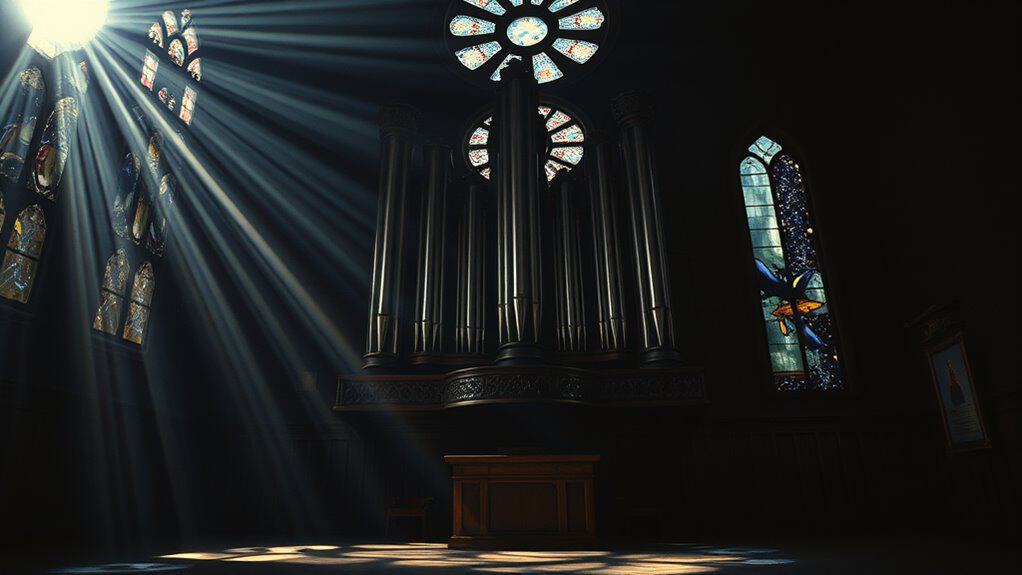
The organ’s powerful melodies resonate not just with human emotion but also echo Christian themes that permeate *Interstellar*. Throughout the film, you’ll find rich Christian symbolism woven into the narrative.
Cooper represents the Father and the Holy Spirit, especially when he joins the Tesseract, while Murph embodies the Son, mirroring the age of Jesus at his death. This connection deepens when you consider the “Lazarus” mission, a clear nod to resurrection and rebirth. Additionally, the film’s portrayal of Cooper’s journey reflects the themes of resurrection experienced in the tale of Lazarus. Furthermore, love’s transformative power is underscored as it drives Cooper’s sacrifices throughout the mission.
Moreover, the mysterious presence that creates the wormhole and Tesseract symbolizes a God-like entity, guiding humanity through its darkest moments. The twelve astronauts reflect the twelve apostles, anchoring the film in biblical tradition. This divine guidance resonates with the concept of divine intervention, illustrating how the characters grapple with their fate.
As you explore these themes, the Tesseract representation stands out, acting as a portal to eternity, a metaphor for the Christian concept of eternal life.
The climax of the story emphasizes love’s redemptive power, echoing Christ’s sacrifice and the eternal bond between Cooper and Murph.
While the film explores humanism, it also leaves you with a sense of divine mystery, inviting you to reflect on the balance between human effort and the possibility of higher intervention.
Emotional and Spiritual Themes

*Interstellar* masterfully intertwines emotional and spiritual themes, drawing viewers into a profound exploration of love, loss, and transcendence. The film’s emotional core resonates deeply, prioritizing feelings over mere scientific spectacle.
The pipe organ, with its rich textures and sudden crescendos, evokes surreal experiences that enhance the narrative, inviting you to experience emotional catharsis as you connect with the characters’ journeys. This score captures the passion and sorrow of their experiences, creating moments that are both heart-wrenching and empowering. The score took two years to complete, showcasing Zimmer’s meticulous craftsmanship that further enriches the film’s emotional depth.
As you engage with the film, the organ becomes a symbol of hope and salvation, urging you to embrace a sense of spiritual awakening while transcending earthly concerns. It encourages a balance between rootedness in human relationships and the pursuit of higher ideals. The film’s score, composed by Hans Zimmer, plays a crucial role in emphasizing these emotional themes throughout the narrative. Additionally, the portrayal of supportive relationships in the film highlights the ability to soothe and uplift others through tenderness, further deepening the emotional resonance.
The themes of love and loss are intricately woven throughout the score, making the cinematic experience unforgettable. In this way, the film not only honors the mystery of love but also respects the spiritual qualities inherent in humanity.
Ultimately, *Interstellar* invites you to reflect on the duality of existence, connecting you to a vast universe filled with both despair and hope.
Musical Influence of the Organ
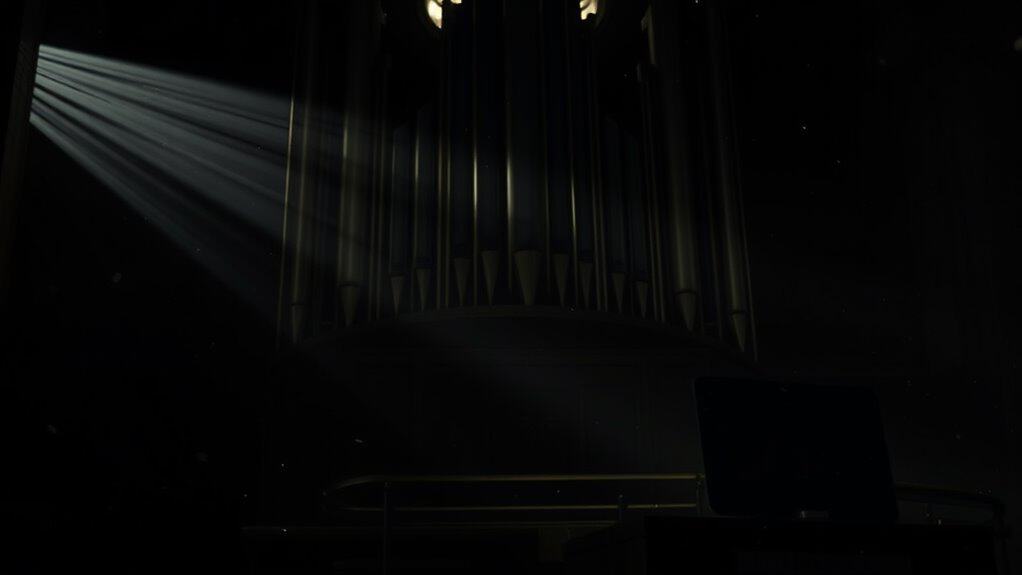
The organ in “Interstellar” serves as a powerful vehicle for emotional resonance, bridging the gap between science and spirituality. As you listen, you can feel how its complex sounds evoke a sense of awe and wonder, enhancing the film’s exploration of humanity’s deepest connections and aspirations. This musical landscape not only underscores the narrative but also invites you to reflect on the vastness of the universe and our place within it. The choice of the organ aimed to evoke a sense of religiosity and metaphysical quality, deepening the film’s exploration of love’s transcendent power. Its prominent use of the pipe organ establishes a unique tone that resonates throughout the score, emphasizing the emotional weight of the characters’ journeys. The score, particularly through the use of orchestral elements, contributes significantly to the film’s atmosphere and emotional depth.
Organ’s Emotional Resonance
With its powerful sound and emotional depth, the organ plays a pivotal role in shaping the musical landscape of *Interstellar*. You can feel the organ’s dynamics, echoing through vast emotional landscapes that capture both awe and intimacy. Its volume and tonal range evoke a profound emotional intensity, essential for the film’s exploration of personal and cosmic themes. Research has shown that organ music can lead to significant reductions in tension and depression, enhancing its role in emotional storytelling. This is particularly evident as Zimmer’s use of the organ emphasizes the parent-child relationships central to the film’s narrative. The organ’s therapeutic applications can create a calming atmosphere that resonates with the viewer’s emotional experience.
As the organ transcends genre conventions, it fosters a deeper connection among viewers, reminding you that emotional resonance can be just as significant as the scientific wonders depicted on screen. The organ’s intricate sound mirrors human breathing, enhancing your emotional bond with the characters. This powerful instrument balances intimate moments with expansive soundscapes, guiding you through the narrative’s highs and lows.
The organ’s thematic variations weave together the film’s narrative strands, underscoring critical relationships, particularly between Cooper and Murphy. By employing an experimental approach, Hans Zimmer invites you to experience the film’s emotional core in a way that’s both reflective and meditative, leaving you with a sense of belonging amidst the vastness of space.
Ultimately, the organ becomes a symbol of hope and despair, resonating long after the credits roll.
Harmonizing Science and Spirituality
Nolan’s vision for *Interstellar* reveals how the organ serves as a bridge between science and spirituality, harmonizing their distinct domains. The organ’s sound embodies a musical transcendence that resonates deeply with your search for understanding. While science constructs models of reality, spirituality invites you to explore the essence of existence through transcendence and self-reflection. This duality is beautifully represented in the film, where the organ’s intricate harmonies symbolize the convergence of these two spheres.
In religious settings, the organ evokes feelings of devotion, yet it also reflects the mathematical precision of music. As you listen, you might find that its ability to mimic human breathing connects you to those emotional and spiritual experiences. The score emphasizes love as a force that transcends scientific boundaries, inviting you to ponder the profound truth that both science and spirituality seek to uncover.
Ultimately, *Interstellar* illustrates how inspiration fuels both scientific discoveries and spiritual insights, suggesting that these methodologies aren’t in opposition, but rather partners in your quest for deeper understanding.
Through the organ, you feel the interplay between the scientific and the metaphysical, creating space for both hope and reflection.
Awe-Inspiring Musical Landscape
Awe-inspiring soundscapes define the emotional landscape of *Interstellar*, with the organ playing a pivotal role in this musical journey. The pipe organ‘s rich and layered tones create an atmosphere that resonates deeply with viewers. By integrating awe-inspiring melodies, Hans Zimmer captures the vastness of space and the intimacy of human experience, allowing you to feel the weight of every breath taken by the astronauts. The organ’s unique sound evokes a sense of longing and hope, contrasting the film’s darker themes.
Zimmer’s choice of the 1926 four-manual Harrison & Harrison organ, recorded in the majestic Temple Church, brings historical significance while enhancing the cosmic soundscapes. Its dynamic range—from subtle whispers to powerful crescendos—mirrors the emotional arcs of the characters, making you feel their struggles and triumphs.
Tracks like “Dreaming of the Crash” and “Stay” highlight the organ’s ability to stir profound emotions, grounding the film’s narrative in a rich auditory experience.
Ultimately, the organ isn’t just an instrument in *Interstellar*; it’s a vehicle for connection, bridging the gap between the film’s themes of hope and despair, inviting you to explore the depths of both space and emotion.
Scientific and Spiritual Duality
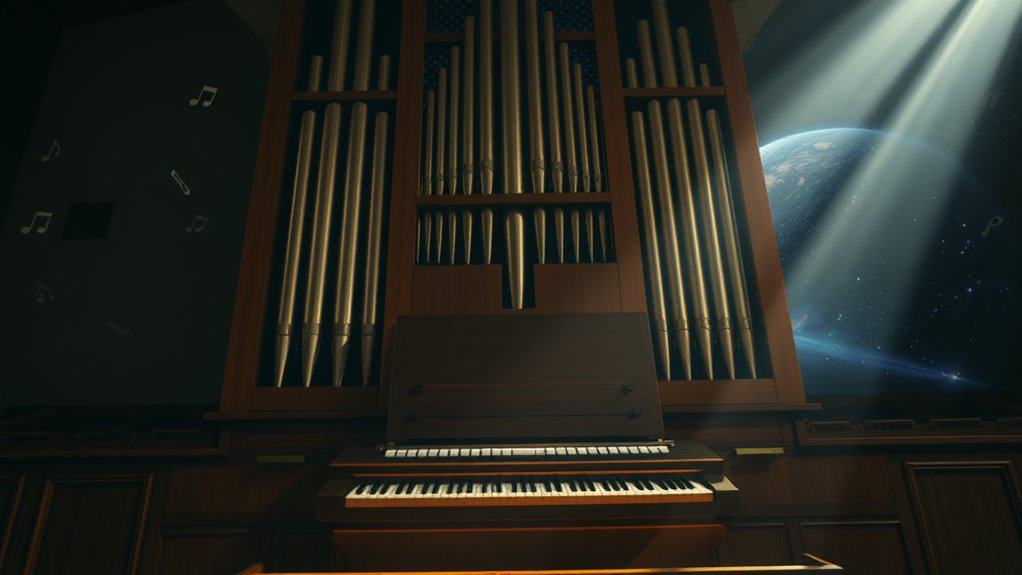
In “Interstellar,” the interplay between scientific inquiry and spiritual exploration creates a rich tapestry that reflects the complexities of human existence. The film invites you to ponder the balance between rational thought and the mysteries that lie beyond our understanding. It emphasizes how both elements influence our journey, whether through the depths of space or the depths of our hearts.
Consider the following dualities present in the film:
- Scientific inquiry reveals the universe’s intricate mechanics, such as black holes and wormholes.
- Spiritual exploration uncovers themes of love and transcendence that defy empirical understanding.
- Time dilation acts as a metaphor for the emotional weight of love, stretching across dimensions.
- Quantum physics hints at a mysterious presence guiding humanity, suggesting a divine connection.
- Relativity theory intertwines with the idea of sacrifice, elevating human experiences beyond mere survival.
This duality mirrors your own struggles, as you navigate the tension between knowledge and belief, hope and despair.
As you engage with both scientific and spiritual themes, you’ll find a deeper understanding of your place in the universe, fostering a sense of belonging amidst the vastness.
Thematic Depth of Interstellar

In “Interstellar,” you witness love as a transcendent force, one that not only connects individuals across time and space but also drives them to make profound sacrifices.
The film intricately weaves scientific exploration with spiritual dimensions, challenging you to contemplate how human connection and purpose intertwine amid the vast cosmos.
As you reflect on these themes, you’ll find that they resonate deeply, inviting you to explore the very essence of what it means to be human in a universe that often feels indifferent.
Love as Transcendent Force
Love serves as a profound, transcendent force in “Interstellar,” shaping the narrative and the characters’ journeys. Throughout the film, love transcends dimensions, impacting time and space in ways that resonate deeply with you.
As you watch, you see how Cooper and Murph’s bond illustrates love’s impact, allowing them to communicate across vast distances. This connection emphasizes that love isn’t merely an emotion; it’s a powerful force driving human actions and understanding.
- Love transcends time and space.
- It fosters communication, even across dimensions.
- Transcendent love surpasses personal desires, promoting unity.
- The father-daughter relationship serves as a prototype of broader love.
- Love’s strength underpins humanity’s resilience and survival.
Scientific and Spiritual Duality
The intricate interplay of scientific principles and spiritual themes forms a rich tapestry in “Interstellar.” By grounding its narrative in theoretical physics, the film invites you to contemplate complex ideas like wormholes and black holes, while simultaneously weaving in profound moral and philosophical questions.
This duality emphasizes the essence of human existence, where scientific exploration coexists with a spiritual journey that seeks meaning beyond mere survival.
As you watch, you witness characters grappling with immense challenges, balancing their understanding of the universe with a longing for connection and purpose. The film’s depiction of time dilation and quantum mechanics serves as a backdrop for deeper reflections on love and sacrifice, illustrating how scientific phenomena can mirror spiritual truths.
The tension between human ingenuity and divine intervention echoes throughout the story, compelling you to ponder whether our fate is solely in our hands or if there’s a greater force at play.
This balance of rational inquiry and mystical experience not only enriches the narrative but also invites you to engage with the vast complexities of life, urging you to find hope amidst despair as you navigate your own scientific and spiritual duality.
Human Connection and Purpose
Human connection serves as a powerful catalyst for purpose in “Interstellar.” As you immerse yourself in the story, you see how relationships drive characters to confront immense challenges, reinforcing the idea that love and sacrifice are central to human experience. The film illustrates how these connections shape the characters’ motivations, pushing them toward purpose exploration.
Consider these aspects of human connection in “Interstellar”:
- Love Transcends Time and Space: The bond among characters transcends physical distance.
- Sacrificial Love: Cooper’s departure showcases the ultimate sacrifice for the greater good.
- Family Bonds: The relationship between Cooper and Murph highlights familial love’s strength.
- Human Connection: Relationships remain essential, even when faced with vast distances and challenges.
- Love as Motivation: Love drives characters’ actions, prompting difficult choices for their loved ones.
Through these connections, the film illustrates that purpose isn’t merely about survival but also about the bonds we forge.
In a universe filled with uncertainty, it’s these relationships that offer solace and hope, reminding you that even in the vastness of space, the essence of humanity lies in connection.
The Organ’s Role in Transcendence

Transcendence resonates deeply within the score of *Interstellar*, particularly through the powerful use of the organ. This instrument embodies a transcendent sound that elevates the film’s exploration of time and space, inviting you into a domain that feels both vast and intimate.
Drawing from the rich tradition of Gothic Cathedrals, the organ’s sound evokes awe and mystery, connecting you to something greater than yourself. The organ symbolism here reflects not only spiritual elevation but also the complexities of human emotion—feelings of isolation and longing permeate the score, reminding you of your own search for belonging.
As you listen, the organ’s majestic tones create a sonic landscape that enhances the film’s themes of cosmic exploration. Each note resonates with a sense of otherworldliness, urging you to contemplate your place in the universe.
The emotional depth conveyed through the organ’s music adds layers to the narrative, allowing you to experience moments of profound connection as well as despair. In this way, the organ serves as a bridge between the earthly and the divine, inviting you to transcend the limitations of your own experience and connect with the mysteries of existence.
Love as a Central Force

Love serves as a powerful undercurrent in *Interstellar*, shaping the characters’ journeys and decisions throughout the film. It’s not just an emotion; it’s love’s influence that propels them through vast challenges, reminding us of the emotional connections that bind us across time and space.
Dr. Amelia Brand articulates this beautifully, suggesting that love transcends dimensions, making it a force worthy of trust.
Consider these aspects of love’s role in the narrative:
- Love is observable and powerful, as seen in the father’s bond with his daughter.
- It drives choices, influencing which planets to explore based on personal ties.
- Love can guide decisions, even when logic falters.
- It serves as a source of strength and a cause for sacrifice.
- The film suggests love exists beyond scientific explanation, hinting at its transcendent nature.
Through these themes, Interstellar explores love’s duality—its capacity to inspire hope and provoke despair.
Ultimately, love emerges as a fundamental aspect of the human experience, reminding us that even in the face of unimaginable odds, our connections can light the path forward.
Conclusion
In “Interstellar,” the organ stands as a haunting echo of humanity’s dual nature, intertwining hope and despair. It resonates like a heartbeat in the vastness of space, reminding us that love transcends even the coldest scientific domains. This instrument not only enriches the film’s emotional landscape but also symbolizes our relentless pursuit of connection amidst uncertainty. Ultimately, the organ embodies the delicate balance between despair and hope, urging us to embrace the beauty of our shared humanity.


